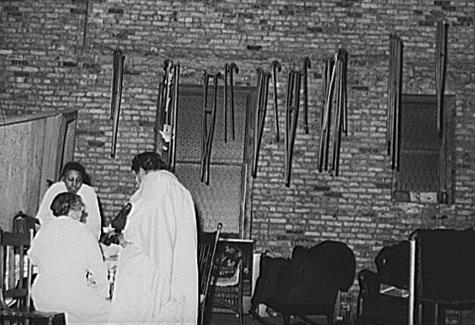A Charismatic Looks at the Birth of Pentecostalism
This idea had occurred in the first centuries and was called modalism but was dispatched as a heresy back in the early church councils. It is true that the Holy Trinity is a difficult concept – more properly a “mystery” that humans can never fully grasp. However, this new modalism was not a good way to understand the relationship of Father, Jesus and Spirit as revealed in the New Testament.[32] Ewart began touring Pentecostal congregations, especially Assemblies of God churches, and re-baptizing believers in the Jesus formula. Many accepted re-baptism without Ewart’s modalism, but some did slip away from Trinitarianism.
By 1915 leaders of the Assemblies of God were concerned about the issue and called a general council to discuss the matter. Ironically, many of the early Pentecostals believed that church creeds were unimportant (and somewhat “Catholic” – and thus bad). They believed one could rely on the guidance of the Spirit for all issues of doctrine. They were reluctant to fashion a new “creed” for this crisis, and so nothing was settled that year. What did happen was that the Oneness pastors were removed from leadership positions. This was not enough, and by 1916 the Assemblies of God issued a “statement of faith” (a creed with a different name) reaffirming Trinitarianism and forcing the Oneness faction out. The Oneness ministers then reorganized into several denominations, but it was almost three decades before they could come together in what is now the “United Pentecostal Church International” (1945).
We should note that the issue of the correct baptismal formula continues to shadow even Trinitarian Pentecostals to this day. In fact, it is a valid issue. A majority of biblical scholars are convinced that the Trinitarian formula was an “add on” to the Gospels from the early Church. [33] This does not mean that the Trinitarian formula, “In the name of the Father, the Son, and the Holy Spirit” is invalid. It may mean the opposite, that the Early Church understood the necessity of the Trinity and its implication for the Christian at the beginning of his spiritual life.[34]
Marginalization of Pentecostalism
Oneness controversy gave further excuse for the mainline churchmen and theologians to marginalize and write-off all forms of Pentecostalism as sect and heresy. The educated clergy of the Second Great Awakening had understood and tolerated the “exercises” of that revival largely because Edward’s revival writings were both widely read and respected. But that situation had changed by the beginning of the Twentieth Century. The “modern” seminaries had little interest in Edwards’ revival writings.[35] Thus the Pentecostals were ridiculed and marginalized as “holy rollers” because of their exuberant “exercises.” Edwards had explained it perfectly a century and a half earlier, but he would not be listened to in the 1900s.
The legalists and liberals had a field day. By the 1930s, mainline Christians had all sorts of “explanations” that reduced Pentecostalism, its “exercises’ and its tongues to a sociological phenomenon and/or psychological aberration. Just one example, a Yale professor, George Bernard Cutten, wrote Speaking with Tongues, Historically and Psychologically Considered, in which he concluded that tongue speaking was a form of hypnotism related to mental illness.[36] It took well into the 1960s for non-prejudiced and well executed scientific surveys using control groups to conclude that tongues were not a psychological abnormality.[37] Their pacifist stand in World War I added to the unpopularity of the Pentecostals.
The Slow Expansion of Pentecostalism
After the first two decades of growth, Pentecostalism settled in to a pattern of routine pastoral ministry and slow growth. The most exciting aspect of Pentecostalism in the between wars period (1918-1941) was its itinerant healing evangelists. For instance, Maria Woodsworth-Etter came into full Pentecostalism in 1912 when she teamed up with F.F. Bosworth for a revival in Dallas. Her prestige as a Holiness healing evangelist nudged many of her followers to embrace full Pentecostalism. She continued a schedule of healing/evangelistic (and now Pentecostal) crusades until her death in 1924. But the most exciting of all (and controversial) in this period was Aimee Semple McPherson, “Sister Aimee” whose unusual and controversial ministry pioneered many of the things that were to become commonplace decades later in the charismatic renewal, such as a relaxed dress code.[38]

Canes and crutches on display at a Pentecostal church in Chicago area, 1941.
During World War II Pentecostals began to acquire a grudging acceptance from mainline Christians. In 1942 Pentecostals became charter members of the National Association of Evangelicals – a major breakthrough in acceptance by other Protestants. After the war TV became a major factor in American life, and in 1953 Oral Roberts began broadcasting his healing crusades on TV. Suddenly Americans could catch a glimpse of “faith-healing” that was exciting, and seemed to work – and came without snakes.
Immediately after World War II there came another outburst of Pentecostalism called the “Latter Rain Movement.” The revival started in the Canadian province of Saskatchewan, at a Pentecostal school and church campus (Feb., 1948). It was marked by a renewed anointing for healing and the usual revival phenomenon of “falling under the power.” But this revival also had the repeated occurrence of a phenomenon called the “heavenly choir” – where music supernaturally flows from the heavens without any apparent source.[39] One person who experienced it wrote:
From a little distance it sounds like a master choir accompanied by a matchless symphony orchestra. It seems difficult to credit that such a sound could be reproduced by human vocal organs. There is such perfect order and timing…[40]
Category: Church History, Fall 2014


